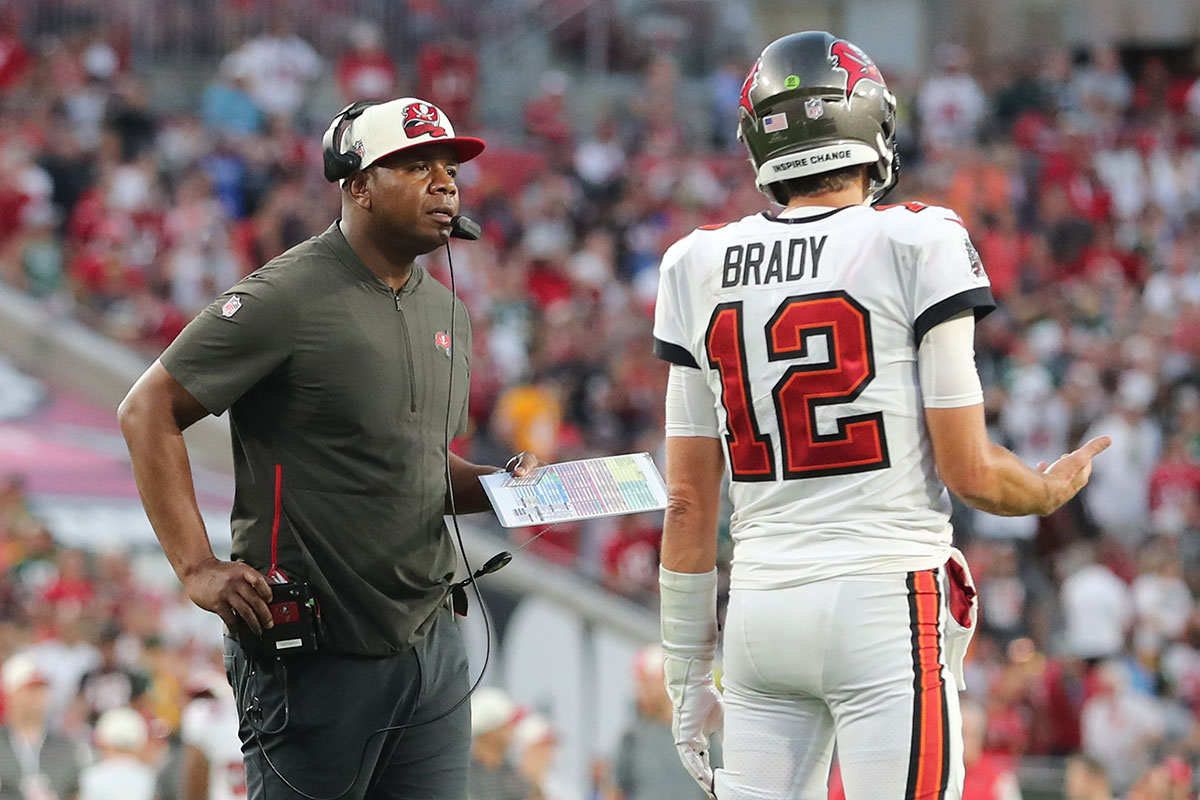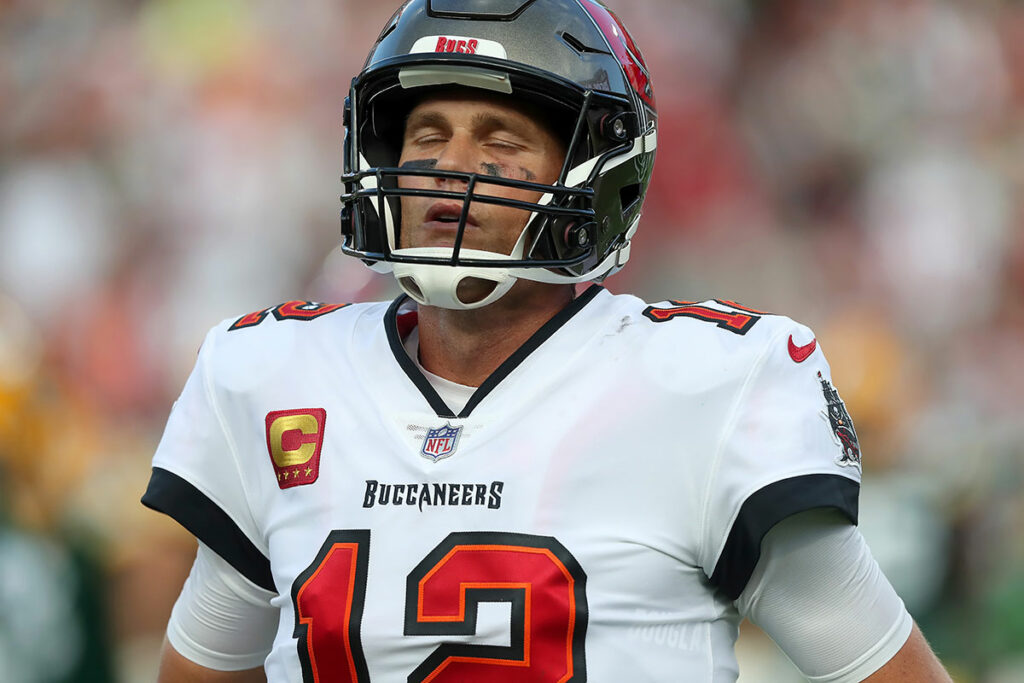Oof. There isn’t much else to say about the Bucs offense against Green Bay in Tampa Bay’s 14-12 loss on Sunday. There was plenty of blame to go around on the day, but in my eyes it all starts with the play caller. Offensive coordinator Byron Leftwich called a bad game and actively made it harder for the Bucs offense to move the ball and score.
Yes, the players who execute the game plan turned the ball over twice. Yes, the offensive line struggled to consistently pass protect. Receivers failed to gain separation, and even ran incorrect routes at times. And through all of that the Bucs should have passed the ball more. Call me crazy, call me an idiot. Just don’t call me Shirley … I mean “wrong.” Don’t call me wrong.
Here is the data to back me up. On first down in non-2-minute drive situations the Bucs ran the ball nine times and passed the ball nine times. The results could not have been more different.
The nine pass plays the Bucs generated 96 yards of offense. Quarterback Tom Brady was five of eight passing for 83 yards. The Bucs picked up the extra 13 yards on a defensive pass interference call against Green Bay. The Bucs picked up five first downs on those nine plays. The nine runs? they generated 17 yards, good for 1.7 yards per carry and zero first downs. The results are similar on second and third downs, but I will spare you the pain.
Now hearing those stats in the abstract may not hit home, so I want to illustrate exactly what the difference is between an aggressive play-caller who trusts his future-Hall Of Fame quarterback, and one who values balance for the sake of balance.
First Down Passing
The Bucs’ longest three plays of the game came on first down in non-two-minute situations. Those five plays were for 25, 24, and 19 yards. Let’s take a look at each of these.
First-and-10, TB 25
First play from scrimmage and Leftwich comes out firing. The Bucs are in a “Kings” personnel package (3 receivers, 1 back and one tight end). Scotty Miller is the “Z” receiver at the bottom of your screen covering up Breshad Perriman in the slot as the “Y.” Russell Gage is lined up close Brady’s backside as the “X.” The Packers match with a dime look on defense with a single-high safety. The Bucs are hoping for Cover 1 and that’s exactly what they get.
The play call is designed to suck in the middle linebacker De’Vondre Campbell with play action and give Perriman space on the crossing route. Notice the route combination underneath Perriman on Brady’s left. Everything is designed to give Perriman space. Gage runs an out to the sticks to keep his man’s back to Perriman. Tight end Ko Kieft gives a chip and runs a short dig to pull the box safety to the opposite side of the field. Running back Leonard Fournette does similarly.
Perriman is matched up against slot corner Rasul Douglas, who just can’t match Perriman’s speed. And since he gave Perriman a clean release, he just loses the foot race across the middle of the field. The safety over the top can’t pinch down until it’s too late because he has to respect the possibility of Gage going vertical on a go or post route. And so, Perriman is wide open for a 24-yard gain.
I’ll note there is no established run to key this play-action pass. It’s the first play of the game. There is a school of thought that the establishment of the run is not necessary for play-action to be effective.
First-and-10, GB 47
Fast forward to the third quarter and the Bucs start in plus territory after Logan Ryan’s interception. This time the Bucs take advantage of the Packers in a Quarters defense. The Bucs run a “sail” concept route combination designed to put vertical stress on two defenders on the outside. They are able to do so by using Scotty Miller who had come across the formation to clear out deep on the post. He is able to draw both the safety and the outside corner with this and effectively draws double-coverage.
This leaves Campbell in conflict as he now has to defend tight end Cam Brate on the deep out and Fournette on the flat. Cambell bites down on Fournette thinking that the corner would pick up Brate, who is left wide open for a 19-yard catch-and-run.
Again, a first down deep passing concept. Again, a big gain.
First-and-10, TB 25 (Again)
I’ll give you one guess as to what type of pass the Bucs ran to get another big gain. Did you guess play-action? Bingo!
This is another variation of a sail concept. This time Perriman is clearing out on a deep nine route for Jaelon Darden running the deep out route. Fournette is again on the flat route. The Bucs might have thought they would get Cover 3, but the Packers end up in Cover 1. No matter, as Darden just beats his man with a good route for 15 yards and picks up 10 more yards after the catch.
There is an old saying. Stop me if you have heard it before. “If it ain’t broke, don’t fix it.” Why Leftwich seems bound and determined to “fix” the Bucs’ first-down passing game by running the ball more is beyond me.
First Down Running
But let’s take a look at a few of those first down runs, shall we? Maybe the play-calling was sound, but execution failed him.
First-and-10, TB 49
On the play directly following the 24-yard reception by Perriman, Leftwich decides to go immediately to a balanced approach and run. There is some creativity to the play call, as he calls for the run out of a traditional pass formation in shotgun.
The right side of the line pulls in the form of Shaq Mason and Tristan Wirfs. Mason executes his block, while Wirfs literally falls down, allowing Campbell to flow to the edge and hone-in on “Lookout!” Lenny. Fournette seeing this, tries to cut back to the inside and finds a lane behind center Robert Hainsey and left tackle Brandon Walton. He is able to push up field for five yards. I will readily admit this is a win by most metrics in terms of yardage to pick up on first down to be considered a success. But it is a win by the narrowest of margins.
First-and-20, TB 13
The best running games in the league average a tick above five yards per carry. So, when faced with first-and-20 it stands to reason that the thought of running the ball should be out of the question. But not with Byron Leftwich. After a holding penalty by Mason that negated a six-yard run by Fournette, Leftwich opts to double-dip in the running well and catch Green Bay off guard.
The offensive line blocks this up well, but the play is doomed because Brate is unable to make it to the second level to get a hat on Campbell. Fournette is able to slip the tackle and avoid a loss on the play before getting stopped for literally no gain. When a play requires 10 yards or more to be considered a success (success on first downs is defined as earning half the needed yardage for another first down) it’s probably best to stay away from the run calls.
First-and-10, TB 14
I included this one to illustrate how Leftwich refused to adjust throughout the game. Let me set the stage for you. It’s early in the fourth quarter. The Bucs are down 14-6 and need a score to really turn the tide. Their defense has played lights out to this point in the second half, having shut down the Packers offense five times including four punts and an interception. The Bucs offense for its part had delivered a single field goal in the back half thus far in the game.
Buddy, the stakes were high. Also please, please keep in mind that to this point the Bucs running game had generated a paltry 3.3 yards per carry, not including Brady’s kneel down to end the first half.
Needing 86 yards to give themselves a chance to tie the game, the Bucs offensive coordinator leans into the absolute least efficient part of his offense. And he is rewarded with no yards for his trouble. Running a wide zone to the right, linebacker Quay Walker is able to push Hainsey back into the line wiping out the “A” gap Fournette was initially looking for. Fournette tries to cut back to the weak side instead of flowing with the line and gets wrapped up by Rashaan Gary for his trouble.
This forces the Bucs offense into two straight plays where they have to pass. Those passes went for three and five yards respectively, leading to Tampa Bay’s fifth punt of the day.
Balance For Balance’s Sake Is Unbalanced
Nine runs compared to nine passes on first down in non-minute situations is about as balanced as one can get, right? But the downside is when one side of that “balanced” coin is that it leads to an unbalanced end-result. Because of those ineffective runs the Bucs only ran the ball three times out of 13 on second down, and twice out of 10 opportunities on third down. When you combine these with the pass-heavy approach the Bucs had to use in the two-minute situations and the Bucs dropped back to pass 45 times as compared to 15 runs. That’s a three to one split! Where’s the balance in that?
Leftwich’s goals and a more efficient game plan are not mutually exclusive either. A heavier pass approach on first down should lead to more first downs because 50% of 18 first downs yield nine runs. But 35% of 24 first downs get you close to the same number. And it gets you more first downs! And even when a first down pass play does not net a new first down, it is more than likely setting up a much more advantageous second down. A second down where a run has a higher likelihood of success. The Bucs can have their cake and eat it too. It just requires a small change from their offensive coordinator.
Some Bonus Fun
After a tough loss, I am sure Bucs fans are looking for something, anything to cheer them up. And so, I give you this from Sunday Night Football:
Jimmy Garoppolo is playing 5 dimensional chess.
Takes the safety before he can throw a pick-6.
What a legend pic.twitter.com/a0wraw542J
— Savage (@SavageSports_) September 26, 2022
There is more than one former Patriots quarterback in the NFL. As Bucs fans, I would think you are glad you have the one you do.




